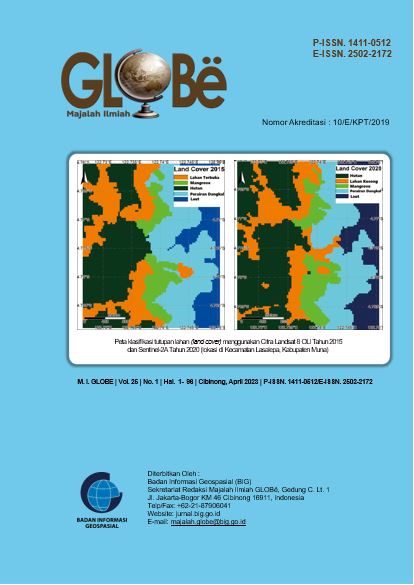LAND USE AND LAND COVER (LULC) CLASSIFICATION WITH MACHINE LEARNING APPROACH USING ORTHOPHOTO DATA
Keywords:
penginderaan jauh, orthophoto, machine learning, LULCAbstract
Penggunaan teknologi penginderaan jauh semakin berkembang, salah satu aplikasinya adalah analisis perubahan penggunaan dan tutupan lahan (LULC). Informasi LULC dibutuhkan untuk berbagai analisis terkait permukaan bumi. Berbagai jenis data digunakan dalam analisis permukaan bumi dengan memanfaatkan data penginderaan jauh. Tujuan dari penelitian ini adalah untuk mengklasifikasikan LULC dengan pendekatan machine learning menggunakan data orthophoto. Lokasi penelitian adalah Desa Tanjung Karang, Mataram, Nusa Tenggara Barat. Metode yang digunakan untuk proses klasifikasi adalah algoritma machine learning yaitu Support Vector Machine (SVM). Dilakukan proses pemisahan band (band slicing) pada data orthophoto yaitu Red, Green, Blue, dan Near Infra Red (NIR). Band Normalized Difference Water Index (NDWI) digunakan untuk analisis badan air yang merupakan refleksi dari band Red dan NIR. Skema klasifikasi klasifikasi yang diterapkan dalam penelitian ini adalah membandingkan klasifikasi antara satu band dan kombinasi band untuk mendapatkan hasil klasifikasi terbaik. Hasil penelitian ini menunjukkan bahwa klasifikasi dengan kombinasi band memiliki akurasi yang lebih baik. Klasifikasi dengan satu band memiliki akurasi rata-rata di bawah 55%, sedangkan kombinasi band memiliki akurasi rata-rata di atas 60%. Hasil klasifikasi dengan nilai akurasi tertinggi adalah kombinasi band R-B-NDWI dengan nilai 71,81%.
References
Ahmad, A., Hashim, U.K.M., Mohd, O., Abdullah, M.M., Sakidin, H. & Sufahani, S.F. (2018). Comparative analysis of support vector machine maximum likelihood and neural network classification on multispectral remote sensing data. International Journal of Advanced Computer Science and Applications, 9(9): 529-37. DOI: https://doi.org/10.14569/IJACSA.2018.090966.
Cai, L., Shi, W., Miao, Z. & Hao, M. (2018). Accuracy assessment measures for object extraction from remote sensing images. Remote Sensing, 10(2), 303, 1-13. DOI: https://doi.org/10.3390/rs10020303.
Chai, L., Jiang, H., Crow, W. T., Liu, S., Zhao, S., Liu, J. & Yang, S. (2020). Estimating corn canopy water content from normalized difference water index (NDWI): An optimized NDWI-Based scheme and its feasibility for retrieving corn VWC. IEEE Transactions on Geoscience and Remote Sensing, 59(10), 8168-8181. DOI: https://doi.org/10.1109/TGRS.2020.3041039.
Chen, Y., Su, W., Li, J. & Sun, Z. (2009). Hierarchical object oriented classification using very high resolution imagery and LIDAR data over urban areas. Advances in Space Research, 43(7), 1101-1110. DOI: https://doi.org/10.1016/j.asr.2008.11.008.
Cortes, C. & Vapnik, V. (1995). Support-Vector Networks. Machine Leaming 20, 273-297. DOI: https://doi.org/10.1007/BF00994018.
Dumitru, C.O., Schwarz, G. & Datcu, M. (2016). Land cover semantic annotation derived from high-resolution SAR images. IEEE Journal of Selected Topics in Applied Earth Observations and Remote Sensing, 9(6), 2215-2232. DOI: https://doi.org/10.1109/JSTARS.2016.2549557.
El-ashmawy, N., Shaker, A. & Yan, W. (2011). Pixel vs object-based image classification techniques for LiDAR intensity data. The International Archives of the Photogrammetry, Remote Sensing and Spatial Information Sciences, XXXVIII-5(W12), 43-48. DOI: https://doi.org/10.5194/isprsarchives-XXXVIII-5-W12-43-2011, 2011.
Foody, G.M. (2002). Status of land cover classification accuracy assessment. Remote Sensing of Environment, 80(1), 185-201. DOI: https://doi.org/10.1016/S0034-4257(01)00295-4.
Huang, J., Zhang, X., Xin, Q., Sun, Y. & Zhang, P. (2019). Automatic building extraction from high-resolution aerial images and LiDAR data using gated residual refinement network. ISPRS Journal of Photogrammetry and Remote Sensing, 151(2019), 91-105. DOI: https://doi.org/10.1016/j.isprsjprs.2019.02.019.
Jamil, A. & Bayram, B. (2017). Tree species extraction and land use/cover classification from high-resolution digital orthophoto maps. IEEE Journal of Selected Topics in Applied Earth Observations and Remote Sensing, 11(1), 89-94. DOI: https://doi.org/10.1109/JSTARS.2017.2756864.
Jozdani, S.E., Johnson, B.A. & Chen, D. (2019). Comparing deep neural networks, ensemble classifiers, and support vector machine algorithms for object-based urban land use/land cover classification. Remote Sensing, 11(14), 1713, 1-24. DOI: https://doi.org/10.3390/rs11141713.
Liu, Y. & Huang, L. (2019). A novel ensemble support vector machine model for land cover classification. International Journal of Distributed Sensor Networks, 15(4), 1-9. DOI: https://doi.org/10.1177/1550147719842732.
López-Jiménez, E., Vasquez-Gomez, J.I., Sanchez-Acevedo, M.A., Herrera-Lozada, J.C. & Uriarte-Arcia, A.V. (2019). Columnar cactus recognition in aerial images using a deep learning approach. Ecological Informatics, 52(2019), 131-138. DOI: https://doi.org/10.1016/j.ecoinf.2019.05.005.
McFeeters, S.K. (1996). The use of the Normalized Difference Water Index (NDWI) in the delineation of open water features. International Journal of Remote Sensing, 17(7), 1425-1432. DOI: https://doi.org/10.1080/01431169608948714.
Noi, P.T. & Kappas, M. (2017). Comparison of Random Forest, k-Nearest Neighbor, and Support Vector Machine Classifiers for land cover classification using Sentinel-2 Imagery. Sensors, 18(1), 18, 1-20. DOI: https://doi.org/10.3390/s18010018.
Pal, M., Akhsay, Rohilla, H. & Teja, B.C. (2020). Patch based land cover classification: A comparison of Deep Learning, SVM and NN classifiers. IGARSS 2020-2020 IEEE International Geoscience and Remote Sensing Symposium, 1933-1936. Waikoloa, Hawaii. USA. DOI: https://doi.org/10.1109/IGARSS39084.2020.9323755.
Qin, R. (2014). A mean shift vector-based shape feature for classification of high spatial resolution remotely sensed imagery. IEEE Journal of Selected Topics in Applied Earth Observations and Remote Sensing, 8(5), 1974-1985. DOI: https://doi.org/10.1109/JSTARS.2014.2357832.
Ramanath, A., Muthusrinivasan, S., Xie, Y., Shekhar, S. & Ramachandra, B. (2019). NDVI versus CNN features in Deep Learning for land cover clasification of aerial images. IGARSS 2019-2019 IEEE International Geoscience and Remote Sensing Symposium, 6483-6486. Yokohama, Japan. DOI: https://doi.org/10.1109/IGARSS.2019.8900165.
Ratajczak, R., Crispim-Junior, C.F., Faure, E., Fervers, B. & Tougne, L. (2019). Automatic land cover reconstruction from historical aerial images: An evaluation of features extraction and classification algorithms. IEEE Transactions on Image Processing, 28(7), 3357-3371. DOI: https://doi.org/10.1109/TIP.2019.2896492.
Thasveen, M.S. & Suresh, S. (2021). Land-use and land-cover classification methods: A review. 2021 Fourth International Conference on Microelectronics, Signals & Systems (ICMSS), 1-6.
Kollam, India. DOI: https://doi.org/10.1109/ICMSS53060.2021.9673623.
Xu, Z., Chen, J., Xia, J., Du, P., Zheng, H. & Gan, L. (2018). Multisource earth observation data for land-cover classification using random forest. IEEE Geoscience and Remote Sensing Letters, 15(5), 789-793. DOI: https://doi.org/10.1109/LGRS.2018.2806223.
Downloads
Published
How to Cite
Issue
Section
License
Copyright (c) 2024 Majalah Ilmiah Globe

This work is licensed under a Creative Commons Attribution-ShareAlike 4.0 International License.






